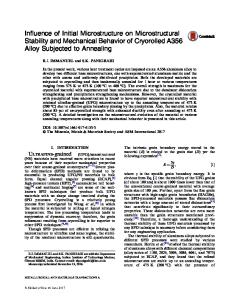A Study on Precipitation Behavior of A356 Alloy by Ultrasonic Velocity Measurements
Al-356 alloy is an aluminum alloy of Al-7Si-0.3 Mg. The effect of solutionizing condition and precipitation hardening on microstructure of this alloy is investigated. The microstructure of a given alloy has a bearing on its mechanical properties. Thus, in
- PDF / 269,965 Bytes
- 6 Pages / 439.37 x 666.142 pts Page_size
- 99 Downloads / 248 Views
A Study on Precipitation Behavior of A356 Alloy by Ultrasonic Velocity Measurements G.V.S. Murthy
Abstract Al-356 alloy is an aluminum alloy of Al-7Si-0.3 Mg. The effect of solutionizing condition and precipitation hardening on microstructure of this alloy is investigated. The microstructure of a given alloy has a bearing on its mechanical properties. Thus, in the present case, a study on the effect of above parameters, namely solutionizing and precipitation hardening on microstructure (optical, SEM), and hardness and ultrasonic velocity (longitudinal velocity), has been made. In the age-hardening process, the precipitates appear in the form of clusters. Nature of distribution of these clusters contributes significantly toward variation in the bulk material of the alloy. In the present investigation, the behavior of solutionizing and aging treatment under varying conditions of temperature and time that result in the morphological changes in microstructure, and ultrasonic velocity for the A356 alloy have been reported. Keywords A356 alloy
⋅
Aging treatment
⋅
Hardness
⋅
Ultrasonic velocity
1 Introduction A group of aluminum alloy is suitable for solutionizing and precipitation-hardening treatment. These alloys are extensively used as structural materials in many industries, for instance, automotive and aerospace, for their excellent castability, high strength-to-density ratio, good fatigue, and corrosion resistance [1]. Thus, in the present investigation, an alloy A356 obtained in the rheocast condition was used for the study. These cast sample were solutionized and followed by aging at different times and temperatures. The resulting microstructures obtained using optical microscope and scanning electron microscope for these samples are reported. In addition to this, ultrasonic pulse echo technique was used to study the variation of
G.V.S. Murthy (✉) CSIR-National Metallurgical Laboratory, Materials Science Division, Jamshedpur, India e-mail: [email protected] © Springer Nature Singapore Pte Ltd. 2018 M. Muruganant et al. (eds.), Frontiers in Materials Processing, Applications, Research and Technology, https://doi.org/10.1007/978-981-10-4819-7_5
47
48
G.V.S. Murthy
longitudinal wave velocity in these treated samples and relate the same with the hardness variation. Ultrasonic testing is the most preferred nondestructive evaluation technique for characterization of material properties. Ultrasonic testing parameters are significantly affected by changes in microstructure and hence the mechanical properties of materials. The measurable properties of material when being tested by ultrasonic methods are the velocity of the sound waves passing through the material and the loss of energy or attenuation of the sound in the material. In the present work, the behavior of precipitation under varying conditions of age hardening was determined using ultrasonic velocity measurements. Further, hardness and microstructural characterizations were carried out to correlate the observed changes in the ultrasonic velocity. Thes
Data Loading...










